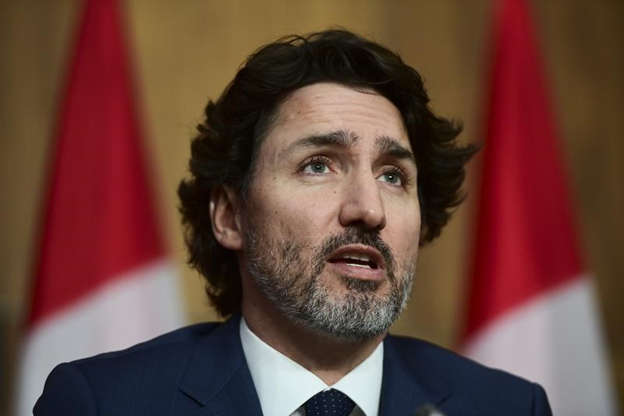Alberta
Alberta justice minister sorry for saying feds, others rooting for COVID disaster

EDMONTON — Alberta’s justice minister says he was wrong to accuse Prime Minister Justin Trudeau’s government, Alberta’s Opposition N-D-P, and the media of rooting for COVID-19 to buckle his province’s health system.
“I would like to offer an apology for my recent comments on my personal Facebook account,” Kaycee Madu wrote on Twitter Tuesday night.
“Alberta is facing an unprecedented public health crisis. My comments were wrong, as all Canadians want this global pandemic to end as soon as possible.
“I fully support the premier’s recent call to avoid the divisive political rhetoric during what we all hope is the final period of this pandemic and will continue the important work of government in protecting Albertans from this virus.”
The apology came a day after Madu’s spokesman, Blaise Boehmer, told reporters in a statement that Madu was standing by his accusations, adding, “The minister won’t apologize for stating the obvious.”
Earlier Tuesday, prior to Madu’s apology, Trudeau rejected the accusations.
“It’s a shame to see people pointing fingers and laying blame and suggesting that anyone in Canada wants anything else than to get through this pandemic as safely as possible everywhere,” Trudeau said in Ottawa.
Premier Jason Kenney, also asked about Madu’s comments prior to the apology, said he hadn’t seen them but said, “COVID has caused us a lot of us at various times to say things we regret, and I just encourage everybody — whatever side of the political spectrum they’re on — to give each other a break right now.”
Trudeau noted he reached out to Kenney and Alberta’s big city mayors last week to offer further support if called upon. Kenney declined the offer.
“Every step of the way the federal government has been there to support Canadians, with $8 out of every $10 in pandemic support coming from the federal government,” said Trudeau.
The issues of blame and responsibility have recently been at the centre of debate in Alberta. Kenney’s government has been criticized for waiting weeks to respond with tighter health restrictions to the current third wave that now threatens to overrun the health system if left unchecked.
Alberta has recently had COVID-19 case rates that are the highest in North America.
Kenney acted with renewed rules a week ago, closing schools and introducing sharper limits on businesses and worship services.
He also stressed now is not the time to lay blame. Prior to that, Kenney and his ministers had repeatedly accused Trudeau’s government of hamstringing the relief effort with a slow vaccine rollout. As late as April 29, Kenney blamed Alberta’s entire third wave on Ottawa.
Last Friday, Madu, in a Facebook post, wrote that the province couldn’t risk giving the COVID-19 virus a chance to “overwhelm our health-care system.
“That’s what the NDP, the media and the federal Liberals were looking for and want,” he wrote.
NDP Leader Rachel Notley said her caucus has done its job as the Official Opposition.
She said they’ve pushed Kenney’s government to enact rules to reduce the spread of the virus, while giving businesses financial aid to survive and workers support to allow them to isolate but still provide for their families.
Notley added, “You don’t tend to see that sort of incendiary, thoughtless messaging or tone from someone who takes on the role of justice minister.”
Dr. Deena Hinshaw, the chief medical officer of health, reported 24,998 active COVID-19 cases Tuesday. There are 705 people in hospital with the illness, 163 of them in intensive care — the highest since the pandemic began.
Hinshaw confirmed the province won’t give out more first doses of the Oxford-AstraZeneca vaccine for the time being.
“Based on global supply challenges, we do not know when Canada, and in turn Alberta, will receive additional doses,” said Hinshaw.
There are 8,400 doses left, which will be used for second shots.
Hinshaw also said they will wait at least 12 weeks between AstraZeneca doses, given current research is showing that the interval delivers the best protection.
Alberta has administered more than 255,000 first doses of AstraZeneca.
This report by The Canadian Press was first published May 11, 2021.
Dean Bennett, The Canadian Press
Alberta
Low oil prices could have big consequences for Alberta’s finances

From the Fraser Institute
By Tegan Hill
Amid the tariff war, the price of West Texas Intermediate oil—a common benchmark—recently dropped below US$60 per barrel. Given every $1 drop in oil prices is an estimated $750 million hit to provincial revenues, if oil prices remain low for long, there could be big implications for Alberta’s budget.
The Smith government already projects a $5.2 billion budget deficit in 2025/26 with continued deficits over the following two years. This year’s deficit is based on oil prices averaging US$68.00 per barrel. While the budget does include a $4 billion “contingency” for unforeseen events, given the economic and fiscal impact of Trump’s tariffs, it could quickly be eaten up.
Budget deficits come with costs for Albertans, who will already pay a projected $600 each in provincial government debt interest in 2025/26. That’s money that could have gone towards health care and education, or even tax relief.
Unfortunately, this is all part of the resource revenue rollercoaster that’s are all too familiar to Albertans.
Resource revenue (including oil and gas royalties) is inherently volatile. In the last 10 years alone, it has been as high as $25.2 billion in 2022/23 and as low as $2.8 billion in 2015/16. The provincial government typically enjoys budget surpluses—and increases government spending—when oil prices and resource revenue is relatively high, but is thrown into deficits when resource revenues inevitably fall.
Fortunately, the Smith government can mitigate this volatility.
The key is limiting the level of resource revenue included in the budget to a set stable amount. Any resource revenue above that stable amount is automatically saved in a rainy-day fund to be withdrawn to maintain that stable amount in the budget during years of relatively low resource revenue. The logic is simple: save during the good times so you can weather the storm during bad times.
Indeed, if the Smith government had created a rainy-day account in 2023, for example, it could have already built up a sizeable fund to help stabilize the budget when resource revenue declines. While the Smith government has deposited some money in the Heritage Fund in recent years, it has not created a dedicated rainy-day account or introduced a similar mechanism to help stabilize provincial finances.
Limiting the amount of resource revenue in the budget, particularly during times of relatively high resource revenue, also tempers demand for higher spending, which is only fiscally sustainable with permanently high resource revenues. In other words, if the government creates a rainy-day account, spending would become more closely align with stable ongoing levels of revenue.
And it’s not too late. To end the boom-bust cycle and finally help stabilize provincial finances, the Smith government should create a rainy-day account.
Alberta
Governments in Alberta should spur homebuilding amid population explosion

From the Fraser Institute
By Tegan Hill and Austin Thompson
In 2024, construction started on 47,827 housing units—the most since 48,336 units in 2007 when population growth was less than half of what it was in 2024.
Alberta has long been viewed as an oasis in Canada’s overheated housing market—a refuge for Canadians priced out of high-cost centres such as Vancouver and Toronto. But the oasis is starting to dry up. House prices and rents in the province have spiked by about one-third since the start of the pandemic. According to a recent Maru poll, more than 70 per cent of Calgarians and Edmontonians doubt they will ever be able to afford a home in their city. Which raises the question: how much longer can this go on?
Alberta’s housing affordability problem reflects a simple reality—not enough homes have been built to accommodate the province’s growing population. The result? More Albertans competing for the same homes and rental units, pushing prices higher.
Population growth has always been volatile in Alberta, but the recent surge, fuelled by record levels of immigration, is unprecedented. Alberta has set new population growth records every year since 2022, culminating in the largest-ever increase of 186,704 new residents in 2024—nearly 70 per cent more than the largest pre-pandemic increase in 2013.
Homebuilding has increased, but not enough to keep pace with the rise in population. In 2024, construction started on 47,827 housing units—the most since 48,336 units in 2007 when population growth was less than half of what it was in 2024.
Moreover, from 1972 to 2019, Alberta added 2.1 new residents (on average) for every housing unit started compared to 3.9 new residents for every housing unit started in 2024. Put differently, today nearly twice as many new residents are potentially competing for each new home compared to historical norms.
While Alberta attracts more Canadians from other provinces than any other province, federal immigration and residency policies drive Alberta’s population growth. So while the provincial government has little control over its population growth, provincial and municipal governments can affect the pace of homebuilding.
For example, recent provincial amendments to the city charters in Calgary and Edmonton have helped standardize building codes, which should minimize cost and complexity for builders who operate across different jurisdictions. Municipal zoning reforms in Calgary, Edmonton and Red Deer have made it easier to build higher-density housing, and Lethbridge and Medicine Hat may soon follow suit. These changes should make it easier and faster to build homes, helping Alberta maintain some of the least restrictive building rules and quickest approval timelines in Canada.
There is, however, room for improvement. Policymakers at both the provincial and municipal level should streamline rules for building, reduce regulatory uncertainty and development costs, and shorten timelines for permit approvals. Calgary, for instance, imposes fees on developers to fund a wide array of public infrastructure—including roads, sewers, libraries, even buses—while Edmonton currently only imposes fees to fund the construction of new firehalls.
It’s difficult to say how long Alberta’s housing affordability woes will endure, but the situation is unlikely to improve unless homebuilding increases, spurred by government policies that facilitate more development.
-

 Media2 days ago
Media2 days agoCBC retracts false claims about residential schools after accusing Rebel News of ‘misinformation’
-

 Bjorn Lomborg1 day ago
Bjorn Lomborg1 day agoNet zero’s cost-benefit ratio is CRAZY high
-

 2025 Federal Election1 day ago
2025 Federal Election1 day agoMark Carney Wants You to Forget He Clearly Opposes the Development and Export of Canada’s Natural Resources
-

 2025 Federal Election1 day ago
2025 Federal Election1 day agoCarney’s Hidden Climate Finance Agenda
-

 2025 Federal Election1 day ago
2025 Federal Election1 day agoPolice Associations Endorse Conservatives. Poilievre Will Shut Down Tent Cities
-

 2025 Federal Election1 day ago
2025 Federal Election1 day agoPolls say Canadians will give Trump what he wants, a Carney victory.
-

 2025 Federal Election1 day ago
2025 Federal Election1 day agoColumnist warns Carney Liberals will consider a home equity tax on primary residences
-

 2025 Federal Election1 day ago
2025 Federal Election1 day agoNine Dead After SUV Plows Into Vancouver Festival Crowd, Raising Election-Eve Concerns Over Public Safety






